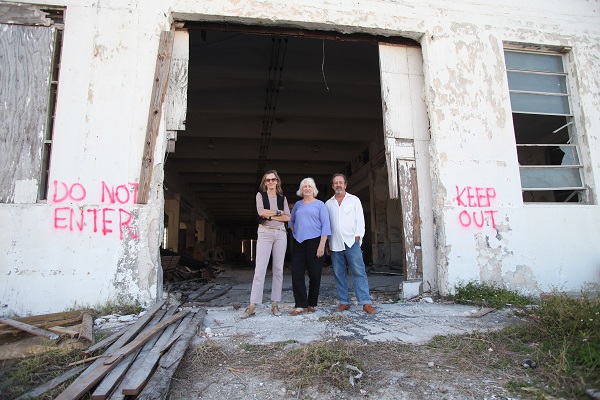A Forgotten Era Remembered: Key West Art & Historical Society Presents “On the Waterfront: Truman Annex Artists” Exhibit at Custom House Museum

On Friday, January 12th from 6:00pm-8:00pm, Key West Art & Historical Society kicks off the new exhibit, “On the Waterfront: Truman Annex Artists” putting the spotlight on a relatively unaccounted for era of creativity that helped launch some of the island’s most celebrated artists. The Custom House Museum exhibit in the Bryan Gallery features historic and contemporary works from artists that rented space between 1974-1986 in the decommissioned naval warehouses, machine-shops, and residential facilities for use as studios after the U.S. Navy abandoned their base on the present-day Truman Annex.
“It was a Golden Age in Key West,” says renowned sculptor John Martini, who enjoyed five years of creating in the 5,000-square-foot 1800s foundry building for which he paid 60 dollars monthly while also operating a sailing school from the nearby dock. “What was left of Duval Street still had Five and Dimes, small businesses, old schoolers, and newcomers. Hippies, smugglers, and gay life was in ascendancy. You recognized most everyone on the street and developers were locally based. Rent was low and drinks were cheap.”
Martini was among an interactive community of artists, ateliers, boat builders, cabinet makers, and other creatives that, by mostly word of mouth, stumbled upon the amenity made available by the City of Key West during a decade when it was doing its best to sell the defunct property prior to purchase by Pritam Singh. He, Helen Harrison, Judi Bradford, Grillo Demo, Dalva Duarte, and Stephanie Sanchez are featured in the exhibit, with black and white photographs of the Annex taken by Monroe County Public Library’s former contract photographer, Adolph Gucinski, serving as the backdrop.
When artists took the helm of the abandoned naval property at Truman Annex, it “was like a ghost town,” says sculptor Helen Harrison, who sailed into town with her husband Ben in 1979 and shortly after rented space for their woodworking.
“The Navy took their papers and walked away from the salt and pepper shakers, tablecloths, plates, silverware, and tools,” she says. “The Truman White House was wide open and there was pigeon poop on everything. It was surreal. We had free reign to explore the 90 acres and our own private beach on the point. If you didn’t pay rent of some kind you were not permitted in. It was a gated community for artists and boaters!”
For all the artists, it was an essential and impactful era in their process, providing them with a spacious place in which to explore and create while perpetuating the opening of renowned galleries that include Lucky Street and Harrison Gallery.
“There were endless supplies of material to scavenge on the grounds, and it allowed me to increase my scale, make as much noise as I desired and provide access to a community of writers, artists, and craftspeople,” says Martini.
“It was a great place to launch an arts career,” adds milliner, textile artist, and illustrator Judi Bradford, who rented 900 square feet of waterfront space behind what is now Truman Little White House from 1980-1983 for her soft sculpture business Lizard Licks with the help of sculptor Reen Stanhouse. “I don’t think the City necessarily intended it for that purpose, but inadvertently it turned out that way.”
For Society curator Cori Convertito, Ph.D., while this forgotten era of history “is but one of several in Key West’s prolonged artistic history,” the exhibit’s focus on Truman Annex and the continuity of our arts community “reinforces the notion that creativity is forever flowing.”
Be sure to flow on over between January 12th and April 1st to check it out.
“On the Waterfront: Truman Annex Artists” will open to the public on Friday, January 12th from 6:00pm-8:00pm, with a suggested donation of $10 for non-members, and free VIP access and reception from 5:30pm-6:00pm for KWAHS members. For more information, call Cori Convertito, Ph.D. at 305.295.6616 x 112 or visit kwahs.org. Your Museums. Your Community. It Takes an Island.

